The Timing Game – MH
The Timing Game describes a playing philosophy in which the right moment of an action is crucial. It not only allows pressing traps to be reversed but also enables teams to break down deep defensive blocks with precision. In the Premier League, Brighton’s then-manager Roberto De Zerbi took this tactical approach to a new level.
“Brighton is a master of passing the ball to the free man but recognising when to pass the ball to the free man and moving at the right time.” – Pep Guardiola
The core idea of the Timing Game is to react to the opponent’s movement at precisely the right moment. Pressing traps can be reversed by first triggering and manipulating the opponent’s press and then bypassing it through changes in speed and direction. Since opposition pressing actions are highly dynamic, this approach is particularly effective against high-pressing teams. Consequently, the Timing Game allows teams to dominate pressing situations in their own buildup play. Additionally, because opponent movements can be triggered independently of the game phase, the Timing Game can also be applied against deep defensive blocks.
Regarding the role of timing in De Zerbi’s buildup play, René Maric (RM) explained in a 2023 interview with SkySports:
„The biggest thing in the build-up is the control of rhythm. If you look at Guardiola, he does it with the speed of the passes and then they carry the ball when they don’t have pressure. De Zerbi does it more with the moment of the pass, the lure, the sole on the ball, opening space with the pass rather than the carry. How you control the rhythm and progress through space will be big in the future. That development has already started.“
This article examines the dimensions and functioning of the Timing Game. Additionally, it analyzes the impact of a team’s own positioning, as well as the manipulation, anticipation, and triggering of the opponent’s press (or movements). The following sections will then explore the action of bypassing the opponent, the potential issues that arise within the Timing Game, and possible solutions to these challenges.
The Different Dimensions of the Timing Game
This section is an attempt to highlight the various facets of the Timing Game and football in general. Different playing philosophies prioritize different dimensions. In the Timing Game described here, particular focus is placed on the timing of dynamics in relation to the opponent.
To gain a better understanding of the principles of the Timing Game, the following section presents and explains its different dimensions. This makes it clear how the Timing Game differs from the focus of positional play and relationism but can also be combined with them. Although the game dimensions are less important for the practical implementation of the Timing Game, they can be useful for further developing this concept or other coaching philosophies.
The most important dimension of the Timing Game is the temporal dimension. The crucial factors are the speed and timing of decision-making. The timing of a progressive action should generally coincide with the opponent’s movement. The primary focus is therefore on the exact moment of an action.
A second important dimension is that of dynamics. The dynamic dimension of the Timing Game revolves around explosiveness and changes in rhythm. Changes in dynamics can be decisive both in relation to one’s own play and in terms of directional shifts in relation to the opponent. Ultimately, the goal is to create the strongest possible reciprocal acceleration in the opponent.
In the dimension of individual performance factors, the focus is on footballing competencies such as technical and athletic abilities. In the Timing Game, ball control is a crucial factor, as it significantly affects a player’s pressing resistance. Ball control involves both the ability to recognize a situation and the technical capability to handle the ball under pressure at any time. This skill is particularly important in the Timing Game, as it provides an advantage during the opponent’s pressing phase.
The causal-relational dimension deals with the cause-and-effect principle in interactions between teammates and opponents. There is a causal relationship both between the opponent’s defensive approach and the method of bypassing them, as well as between a teammate’s action and the resulting ball action. The following examples illustrate this:
- In the Timing Game, opponent man-marking (cause) requires different offensive movements (effect) compared to opponent zonal marking.
- Additionally, a teammate’s movement toward the ball (cause) requires a pass played to their feet (effect).
In relationism, interactions between teammates are particularly emphasized to enable optimal interplay. Due to the complexity of this dimension, I have linked MR’s seminar “The Future of the Game” here.
In the spatial dimension, the focus is on controlling specific zones of the pitch. This is particularly crucial in positional play, where the aim is to control the game through ball possession and spatial occupation. In the Timing Game, however, the goal is to reach the space behind the opponent. Since this space is constantly changing, it cannot strictly be defined as a fixed pitch zone. However, the spatial dimension does play a role in the preparatory positioning of the Timing Game. This article contains a dedicated section on the optimal positioning in preparation for the Timing Game.
The Functioning Depending on the Opponent’s Pressing Styles
In the Timing Game, the moment of an action is primarily decisive. The moment of action is always triggered by the opponent’s movement. The more intense the opponent’s movement, the easier it is to bypass them. This is because, once the Timing Game is triggered, the opponent should be bypassed as diagonally opposed to their movement as possible. This forces the opponent into a maximal change of direction and dynamics.
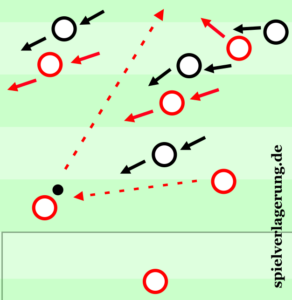
The pressing near one’s own penalty area is bypassed diagonally opposite to the direction of the press.
A temporal advantage is created over the opponent, who initially has to accelerate in the opposite direction and loses time. The space that opens up behind the advancing opponent can be played most effectively. Representing the functioning of the Timing Game, the principle of “Lure and Shock” could be used. The opponent is first “lured” into the movement and then “shocked” by being bypassed.
The Timing Game is particularly effective during the opponent’s transition from a deeper to a higher pressing setup. At the moment of transition between ordered pressing phases, the opponent’s structure is often lacking, as the distances between the players change. Additionally, movement is present on all positions of the opponent, which can be exploited for the Timing Game. The direction of the opponent’s movement is also crucial, as during the transition from a deeper to a higher pressing phase, vertical movement away from the goal dominates, allowing spaces towards the opponent’s goal to be exploited.
This specific moment of the opponent’s pressing transition into a higher setup cannot be found in the classic phase model of the game according to Van Gaal. Depending on the perspective, it would be classified as part of either the team’s own possession phase or the opponent’s possession phase, even though it is significantly more complex and interesting than other possession situations. The opponent is essentially in a type of defensive transition into attack from the opponent’s ball possession, while the own team takes advantage of this moment and transitions from their own ball possession into a kind of offensive transition.
The Timing Game, however, does not only work during transitions between different pressing setups, but also independently of the game phase, and thus also within the framework of the opponent’s attacking press. The opponent’s movement in attacking pressing usually does not need to be triggered additionally. Instead, it is more about anticipating the moment when the opponent’s attacking press is triggered. At the moment of pressing initiation, there is a very high dynamic on multiple positions of the opponent in (diagonal) vertical directions, which allows the pressing to be bypassed with suitable movements at the moment of initiation. Particularly, the opponent’s pressing traps can be bypassed at the moment of initiation through a corresponding pre-rehearsed anticipation and movement.
Depending on the individual pressing patterns of the opponent, preparations should be made for the timing and manner of bypassing. For example, man-marking in attacking pressing can be bypassed differently than ball-oriented or hybrid marking schemes. Particularly against man-marking, it is important in the Timing Game to initially provoke dynamics in the opponent through various runs, in order to then bypass them in the opposite direction. If dynamics are not created through own runs, there is often little movement from the opponent in the second and third layers that could be exploited.
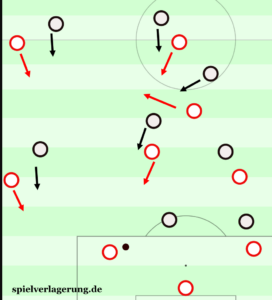
Because dynamics are also created in the opponent’s man-marking in the second and third layers, multiple layers can be bypassed.
The pressing triggers and pressing traps also differ depending on the type of attacking press, so anticipating the moments of the Timing Game requires prior analysis of the opponent. A very commonly used pressing trigger is a backward pass to the goalkeeper from a higher defensive line. A common reaction is for the goalkeeper to play the ball long under pressure, usually resulting in a loss of possession. In the Timing Game, a team would create passing options behind the opponent through collective movements at the moment the opponent triggers their press. Specific movements and methods for bypassing the press will be discussed in more detail later in the article.
Individual pressing patterns also include the opponent’s pressing structure itself. Here too, individual weaknesses can be diagnosed and exploited in advance. When the opponent presses from a 4-4-2, they often have an under-populated central area. Of course, this cannot be generalized, as, for example, the ball-far midfielder or an aggressive center-back may situationally reinforce the center. However, if this is not the case, an inverse run by the full-back at the moment the press is triggered could be useful to play into the space behind the press against the dynamics. It can be stated that the Timing Game, against different opponents with different individual pressing patterns, influences the movements made to bypass the press.
The Timing Game can also work against deep-lying opponents. However, it is more difficult here because, in general, there is less movement away from the goal, and the opponent attacks in a more passive manner. The deep-lying opponent’s goal is to close the space near the goal. It will be crucial to trigger the opponent’s movement or pressing and lure the opponent out. We will go into more detail on such trigger actions later.
In summary, the following rules for the Timing Game depending on the opponent’s pressing can be established: The deeper the opponent is positioned, the less dynamic movement there is away from their own goal. Therefore, the time window for bypassing the press is shorter. The more passive the opponent acts, the less frequently there is opponent movement. As a result, there will be fewer opportunities to bypass the press. Nevertheless, the Timing Game can be used independently of the game phase through trigger actions.
Formation in Possession to Prepare for the Timing Game
The team’s formation in possession should be adapted to the challenges of the Timing Game. It should create central connections through a vertical/diagonal alignment. This way, more layers can be incorporated into the dynamics, and more passing options can be created. More passing windows open up at the moment of triggering through a variety of passing angles. In the event of a loss of possession, it also allows for more effective counter-pressing.
Additionally, it can be useful to work with asymmetries and overloads. Overloading the own buildup zone is particularly effective when the opponent closes down and applies high pressure. This lures the opponent and allows them to be bypassed with a few passes. In the linked video example, De Zerbi’s Shakhtar Donetsk uses a strategy of having 7 players in their own penalty area during a goal kick to lure the opponent out.
Nothing to see here, just a completely normal build-up pic.twitter.com/vOcvRPVKdf
— Jamie Hamilton (@stirling_j) April 28, 2022
Problems in the Timing Game arise when there is an overload in the own buildup zone if the opponent does not press. The progression in the game is lacking because offensive passing options are not available. Also problematic is the static overload of the last line. If players remain in their specific spaces in the last line, passing options necessary to bypass the opponent’s press are missing.
Another way to structure the team to prepare for the Timing Game is by leaving a specific area vacant. If the opponent attempts to press, this space is usually left unoccupied by the opponent as well. Subsequently, the space can be attacked and played into from the second line in the opposite direction. If the space is still occupied, the numerical advantage in a ball-near area can be exploited. Real Madrid often employs such structures or space-drawing runs in preparation for their actual attacking play with the ball.
Anticipating and Triggering the Opponent’s Attacking Press
In the Timing Game, the moment the opponent begins to press must be anticipated as early as possible. Possible indicators for early recognition of a pressing moment include: the opponent’s approach towards the ball-carrying teammate, the shrinking of distances between the ball-near opponents and their teammates, and the forward dynamics of the opponent. A defensive line with equal numbers or an advancing defender is also an early recognition feature. Lastly, specific pressing triggers should be identified through video analysis in advance.
An exemplary player for effective pressing resistance is Sergio Busquets, who, with his excellent ball control, was regularly able to anticipate and resolve pressing situations. In this 2017 article, TR and MR wrote about Busquets’ qualities.
What is particularly interesting is triggering the opponent’s attacking press. There are a variety of very interesting trigger actions. One variation used by De Zerbi is the use of the sole on the ball to wait. This plays on the impatience of the opponent. The following quote and video clearly demonstrate the effectiveness of this trigger action.
“It’s so fascinating to watch (…) when the ball goes to the center back, they freeze the game. (…) As soon as the pressing action happened, they then had this meticulously designed mechanism of up-back-throughs and third man connections (…).” – Jamie Hamilton, 3rd Circle Podcast
— Jamie Hamilton (@stirling_j) January 13, 2025
Another option is a pass triggered by speed. This pass should be played as slowly as possible and as quickly as necessary. The slow pass provokes the opponent’s pressing. At the same time, by the receiver moving towards the ball, the dynamics can immediately be reversed. This facilitates the transition into the action of bypassing or dribbling past the opponent. The pass direction should ideally be diagonal toward one’s own goal. This maximizes the reversal of dynamics.
Another approach is to play into the pressure, only to then “bounce” back into the direction of the opponent’s pressing path. The opponent is initially led to believe they have access by playing into the pressure. By bouncing the ball into the pressing direction, the opponent is forced to continue their run.
The classic way of forcing a passive opponent into movement is dribbling. The opponent is eventually made to press. However, it is also much harder to generate a dynamic shift and surprise effect, as the dribbling is already in the direction of play. Therefore, it is helpful if dribbling-skilled players attack the opponent in order to maintain the unpredictability of the next action with quick changes of direction. Alternatively, passes that bypass the opponent after dribbling in the opposite direction of the dribble path can create a dynamic shift in the opponent.
Against deep-lying opponents, the inside diagonal is a good method to force defenders on the last line to step out a few meters. When the ball is played diagonally from the outside to the center, the central defender steps out a few steps. This can be exploited in the opposite direction. The effect is enhanced by a player letting the ball pass, as immediately after, the defender’s back can be attacked. This move is known in relationism as Escadinha.
— Svids (@Svids8) February 23, 2025
The Basic Principles for the Action of Bypassing in the Timing Game
After the pressing trigger, the opponent should be bypassed through dynamic, diagonal directional changes. The direction of the first action should ideally not move away from the pressure but rather target, go over, or through it to attack the opponent’s movement. Instead of directly passing to the free player (e.g., the goalkeeper), a progressive, diagonal ball should be chosen.
To create passing options in the desired direction, specific movements are crucial. There are also various fundamental principles for this. The start of the ball action should be as late as possible but as early as necessary.
The timing of the movement of teammates should coincide with the moment the press begins, so they can be available to receive the ball under pressure, but not too early to avoid being caught by the opponent’s dynamic.
Dynamic movement should also be generated in the second and third layers to have the opportunity to bypass multiple layers. Otherwise, there is a risk of opponents from the second layer, who create covering shadows, not being affected by the opposing dynamic. In a less compact space behind the first pressing line, the dynamics can occur in stages, so the layers are played one after the other.
It is important that after an action, the next layer should be attacked immediately to maintain the dynamic.
The decisive action to overcome the opponent can be individual, group, or team tactical in nature. Below are specific examples of such actions.
A feint in the moment of pressing initiation can lead to bypassing the opponent. In the linked video, Musiala’s movement at the right moment leads to the goal. Although this movement is likely executed intuitively by Musiala at the right time, it can certainly be tactically repeated. The feint falls into the above-described phase of the pressing transition from a deeper to a higher pressing line, which is why Denmark’s player spacing is incorrect and the deep coverage is absent.
Brilliant angle of Jamal Musiala’s goal from last night. 🇩🇪#Germany #Denmark #Euro #Analysis pic.twitter.com/xl2MDgvXwb
— Jamie Kyte (@jamielkyte) June 30, 2024
Individually tactical, the first touch can be used both as a triggering action and as an overcoming action. By skillfully triggering the opponent’s movement, it may be enough to simply play the ball past the opponent or through their legs. The first touch is made as far as possible but as close as necessary to allow the player to regain possession of the ball immediately in front of the opponent. This is clearly seen at the very beginning of Woltemade’s first goal in the following video.
⚽#woltemade #u21 pic.twitter.com/mpdKiB4inJ
— ran (@ransport) March 25, 2025
The no-look pass can also be a variant to surprise the opponent against the dynamics and running direction.
Madrid pic.twitter.com/z2nyPVIuPi
— Svids (@Svids8) December 19, 2024
Florian Wirtz’s dribbles may initially seem unremarkable. However, upon closer observation, it becomes clear that Wirtz uses slight delays instead of flashy tricks to trigger the opponent’s movement, and then he moves the ball past the defender. This is also a form of timing play at the individual tactical level.
@MunichComps pic.twitter.com/qNsq4Ljltc
— thomassist (@thomassist25_) January 27, 2025
On the group tactical level, up-back-through (steil-klatsch) combinations are ideal for breaking into depth at the right moment. Here, the previously described positioning in preparation for the timing play is crucial. As many levels as possible should be occupied to open passing angles and options. The lay-off play has the advantage of being able to overcome the opponent with simple passes. It is remarkable how each of these passes is played against the opponent’s pressing direction, preventing the opponent from getting access to the ball.
— ファンキーヤング (@funkyyoung) November 19, 2024
Different variations of the play through the third man are also very effective. In the following video, the effectiveness can be admired at minute 0:13, using the example of the left center-back starting in the wrong direction.
— Svids (@Svids8) February 20, 2025
Other possibilities in the group tactical area include one-twos against the dynamics, space-creating runs, counter movements, or dynamic zone rotations.
There are also team tactical variations for overcoming the opponent in the timing game. One such variation is playing the second ball directly into the backline with an appropriate zone overload at the moment the pressing is triggered. The preparatory positioning is the team tactical element here.
A team tactical counter movement could also be considered, where all players in the forward zones drop back, increasing the pressing distance to create more dynamic movement. At the same time, a player from the second line attacks deeply in the opposite direction.
Problems of Timing Play and Solutions
One problem with the timing play is overcoming the covering shadow of the first pressing opponent. As the approaching opponent generates an increasingly larger covering shadow in a well-prepared pressing situation, passing options become limited. This can be solved through an individual tactical overcoming action, such as a dribble, a first touch, or others. Additionally, certain combination plays can help overcome the first pressing player. A back-up-back-through combination could be effective, where the first pass is played over a short distance to a nearby teammate (back), followed by an up-back-through combination to open new passing angles.
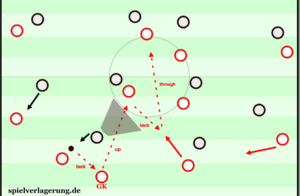
The short back pass to the goalkeeper, who has moved up into the defensive line, can bypass the covering shadow of the first pressing player.
Another problem could arise against teams with a very high pressing intensity. Since it is necessary to play into the pressure and trigger the pressing, one is systematically exposed to this high intensity repeatedly. However, this can also be used to one’s advantage. Opponents with high intensity also have high dynamics, which can be played against with greater effectiveness. Additionally, there is usually a high number of opponents in the attacking zones. Therefore, it is advisable to attack the farthest free space as directly as possible.
Hybrid pressing can also cause problems in the timings game. Since individual players act in specific spaces, responding situationally to regain possession of the ball, they do not necessarily carry the dynamics of the pressing players. As a result, they are more difficult to play past. However, certain off-ball runs could provide solutions here. One example would be the outside defender making a diagonal run into space far from the ball.
Lastly, there are issues when pressing the opponent during goal kicks. All playing philosophies face problems here, as the conditions to break out of the situation are not ideal. The ball is not in motion, the opponent can organize, and the playing field is limited by the goal line behind. Additionally, the risk is higher due to the proximity to the goal. The timings game would generate dynamics in the opponent by various runs from teammates, in order to reach the opponent’s back at the right moment.
Conclusion
The concept of dynamically timing a play to exploit the opponent’s movement at the right moment is already seen in practice. However, with a more deliberate approach, it can become more accessible to a wider range of players and even more effective. It holds the potential to bypass pressing traps and break down deep-lying defenses. It is not only applicable throughout the field but can also be effective with different numbers of players.
The dynamic timing play concept developed here is heavily focused on the reference point of the “opponent.” Another possible concept of timing could place more emphasis on the teammate, focusing on relational interactions between players. This concept would be more closely aligned with the relationalism theory. Using the dimensions outlined here, different game concepts can be created and further developed.
The timing play should be used as a complementary element to complete one’s overall playing philosophy. It provides a different perspective on tactical analysis than what would be possible with static graphics, such as those on a tactic board. Therefore, it should expand an analyst’s perspective on this complex game by adding an additional dimension.
Author: MH is a football aficionado at heart. His apartment resembles a football library, with shelves filled with books on the great tacticians from Rinus Michels to Pep Guardiola. Of course, the book from Spielverlagerung.de is not missing. For MH, football is not just a game, it’s a way of life. He can be found on X under Mh_sv5 and LinkedIn.
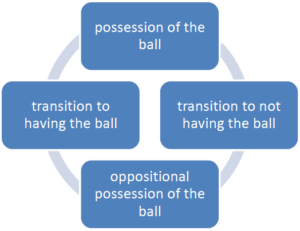
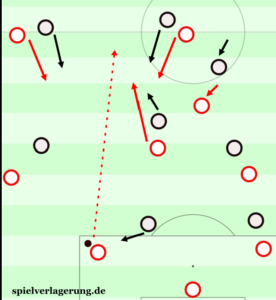
1 Kommentar Alle anzeigen
Brian Muturi May 27, 2025 um 7:40 am
I know Pep Guardiola made De Zerbi the leading authority when it comes to the timing game but I also believe that Marcelino Garcia at Villarreal adds more layers to this topic. His understanding of dynamics is unique and is worth looking into.